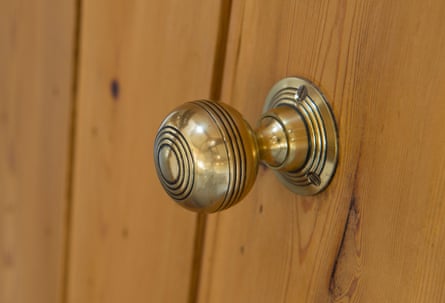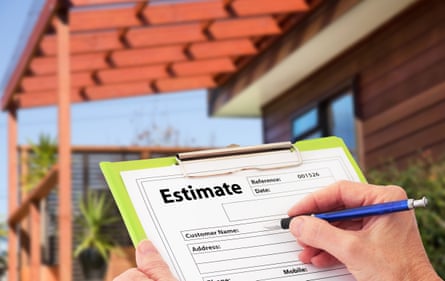Five ways to save money on DIY jobs | Home improvements

Place your focus on the small jobs
The cost of materials for big home improvements such as loft conversions and extensions is soaring. Prices change all the time but Office for National Statistics figures show they are on average 26% higher than a year ago. In that period, the cost of steel bars, for example, has risen by about 58%.
However, you don’t need to extend your loft or replace your kitchen to transform your home. You can focus on smaller jobs such as replacing doors, handles and taps, and painting cabinets and wooden tables for a new look. There are lots of money-saving bloggers and upcycling influencers such as @crack_the_shutters, @ joannecondon and Shoestring Cottage that may offer inspiration.
Joanne Condon, the author of Furniture Crush, and an upcycling expert, says: “As the new trend of working from home collides with the rising cost of living, we need to look at how we can make better use of our homes without spending a fortune.

“We also need to think of multifunctional uses when we think of items we already have in our homes. For example, old drawers can turn into mini herb gardens, planting pots, pet beds and wall shelves. You can upcycle a wardrobe into a pantry press or bookcase by shelving it.”
Buy ex-display or secondhand
If you want to take on the big jobs, you can buy former showroom kitchens and bathrooms at a fraction of their original price. The Used Kitchen Company has a wide range of ex-display kitchens and bathrooms. For example, one kitchen listed had a recommended retail price of £21,000 but was sold for £7,900.
Here you can also sell your old units and furniture on the website, or try eBay and Facebook Marketplace. You can find secondhand bathroom suites on these sites, and save on items such as new taps and showerheads.
Lisa Webb, a consumer law expert at the consumer body Which?, says: “Buying a pre-loved kitchen is an environmentally friendly way to cut costs.
“However, you should make sure you check all the dimensions before purchasing, and arrange a viewing to check the kitchen yourself, inside and out.
“Be aware that if you’re buying from a private seller you have less protection than when buying from a trader – the goods must be as described but they don’t have to disclose any faults.

Photograph: Pens Forms/Alamy
“Make sure you check carefully for any issues when you see the kitchen and – if you find a fault and decide to go ahead with the purchase – find out whether they will be cheap to fix, as you don’t want to pay more than expected to rectify any significant faults.”
Plan your projects carefully
Get at least three quotes to compare the cost of any professional work, and request the total price including all the fixtures and fittings. Confirm the timeframe and the cost for the entire project in writing, too, so there are less likely to be nasty surprises.
The project cost will depend on several factors, including where you live, the amount of work needed and the size of your home. MyBuilder.com lists guide prices for standard projects such as loft extensions and double glazing jobs.
Noble Francis, the economics director at the Construction Products Association, says: “Plan and purchase the materials needed for the job in advance to avoid delays and cost rises down the line. The more materials that you or the builder will go to purchase from the merchant on the day during the project, the greater the cost.”
If you are buying several new fixtures and fittings, take the time to shop around and negotiate a package, with everything you need to install the parts included, too.

Choose the right finance for your work
How you finance home improvements depends on the cost of the project. If you are painting your house, you may be able to finance the cost from savings. Alternatively, some or all of the cost could be put on a credit card on a 0% interest deal for purchases, provided you can get a large enough credit limit.
For example, Sainsbury’s Bank, M&S Bank and Barclaycard are currently offering new applicants up to 24 months’ interest-free on purchases.
Andrew Hagger of the financial website MoneyComms.co.uk explains: “You’ll also benefit from section 75 protection on any purchases over £100 and below £30,000. So if you have any faults or disputes that you can’t resolve, you can ask your credit card provider to step in.”
If you need to borrow up to £25,000, you may want to check out unsecured personal loans. Rates remain low at between 3.1% and 3.5% for the best-buy loans – provided you have a good credit rating. You won’t pay set-up fees, unlike with mortgages. For example, if you borrowed £20,000 over five years from Tesco Bank on a rate of 3.2%, you would have to repay £360.74 a month. In total, you would repay £21,644.
If you are borrowing more than £25,000, the cheapest option for many people is likely to be remortgaging. If you are arriving at the end of your current home loan deal, you can remortgage to release some equity and grab a fixed-rate deal before interest rates rise again.
Check energy efficiency grants
As energy bills soar, you may be thinking about insulating your home in the run-up to the winter months. You could do this for free if you are with a big energy supplier, receive certain benefits and have an annual income of £16,190 or less.

Under the Energy Company Obligation scheme, some people can get free or heavily subsidised loft and wall insulation if they claim particular benefits. There is a full list of qualifying benefits here. You can check if you qualify using the Simple Energy Advice calculator in England or Wales, or contact Home Energy Scotland.
Once you have checked whether you are eligible, you will need to contact your supplier to sort out a survey. You will either get the insulation installed for free, or receive a grant to cover some or all of the costs.
For the full list of suppliers signed up to the scheme, visit Ofgem’s website.







